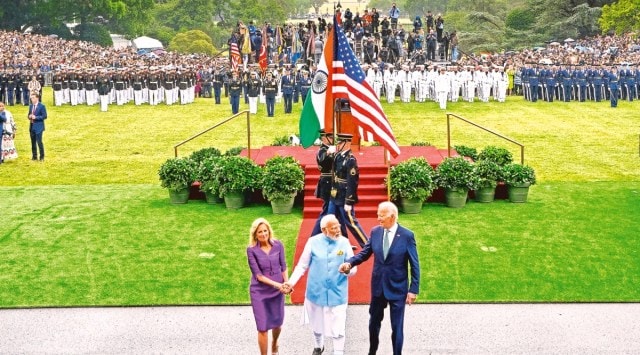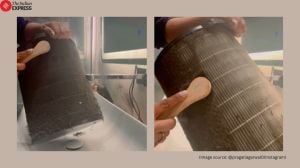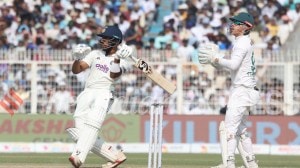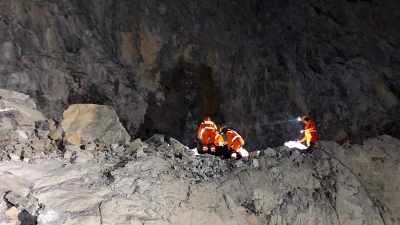India joins US-led critical mineral club, boost likely for EV, electronics
India’s inclusion assumes significance given that one of the key elements of New Delhi’s growth strategy is powered by an ambitious shift in the mobility space through the conversion of a large part of public and private transport to electric vehicles
 President Joe Biden, First Lady Jill Biden, with Indian Prime Minister Narendra Modi, walk into the White House at the conclusion of a State Arrival Ceremony on the South Lawn of the White House, Thursday, June 22, 2023, in Washington. (AP Photo)
President Joe Biden, First Lady Jill Biden, with Indian Prime Minister Narendra Modi, walk into the White House at the conclusion of a State Arrival Ceremony on the South Lawn of the White House, Thursday, June 22, 2023, in Washington. (AP Photo) INDIA HAS been inducted into the Mineral Security Partnership (MSP), a US-led collaboration of 14 countries that aims to catalyse public and private investment in critical mineral supply chains globally.
The India-US joint statement issued early Friday, reiterating the intention of the two governments “to work together to ensure that our respective markets are well-supplied with the essential critical minerals” and reaffirming a pledge by the two sides “to hasten bilateral collaboration to secure resilient critical minerals supply chains”, welcomed India into the grouping.
“The US enthusiastically welcomes India as the newest partner in the MSP, to accelerate the development of diverse and sustainable critical energy minerals supply chains globally while agreeing to the principles of the MSP including environmental, social, and governance standards,” the joint statement said.
India’s inclusion assumes significance given that one of the key elements of New Delhi’s growth strategy is powered by an ambitious shift in the mobility space through the conversion of a large part of public and private transport to electric vehicles. This, alongside a concerted electronics manufacturing and semiconductor push, underlines the need to secure the supply of critical minerals.
The proposal to onboard India comes after a strong diplomatic push mounted by New Delhi, given that there was considerable disquiet within sections of the Union government over the country not finding a place in the strategic partnership that is also aimed at reducing dependency on China for securing critical minerals. The concerns grew after the partnership, originally floated mid last year, was expanded earlier this year to include Italy.
The MSP is learnt to have weighed the possibility of collaborative work on some 150-odd projects and shortlisted a dozen projects where members are likely to commence work, including fostering a critical minerals and metals cooperation forum for sharing of expertise, developing battery materials and jointly developing a minerals processing facility in South America. Official sources here indicated that while there was a strong interest in India joining the group, there was also a debate within sections of the government over some trade-offs involved on part of those signing up for a membership. Besides the US, the MSP includes Australia, Canada, Finland, France, Germany, Japan, the Republic of Korea, Sweden, UK, the European Commission, Italy, and now India.
The grouping, industry insiders say, could focus on the supply chains of minerals such as cobalt, nickel, lithium and also the 17 “rare earth” minerals. While cobalt, nickel and lithium are required for batteries used in electric vehicles, rare earth minerals are critical, in trace amounts, in the semiconductors and high-end electronics manufacturing. China is a strong player in this space and has created processing infrastructure in rare earth minerals and has acquired mines in Africa for sourcing elements such as cobalt.
Rare earth comprises 17 elements and are classified as light RE elements (LREE) and heavy RE elements (HREE). Some REs are available in India such as lanthanum, cerium, neodymium, praseodymium and samarium, while others such as dysprosium, terbium, europium that are classified as HREE are not available in Indian deposits in extractable quantities. Currently, there is an overwhelming dependence on countries such as China for HREE, which is one of the leading producers of RE with an estimated 70 per cent of the global production.
India is seen as a late mover in attempts to enter the lithium value chain, coming at a time when EVs are predicted to be a sector ripe for disruption. The year 2023 could be an inflection point for battery technology – with several potential improvements to the Li-ion technology, and alternatives to this combination in various stages of commercialisation.








